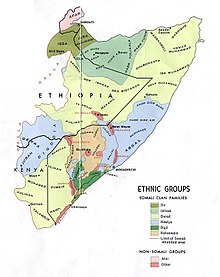Issa (clan)
The Issa (also Ise , 'Iise ; Somali Ciise ) are a clan of Somaliland . They belong to the Dir clan family and make up the majority of the population in Djibouti , they also live in the Awdal region in northwest Somalia ( Somaliland ) and in the neighboring Ethiopian Somali region ( Ogaden ), especially in the Shinile zone . They traditionally live as nomadic ranchers, but they also trade and have contacts throughout the region.
Since the colonial era, the Issa have increasingly penetrated north and west into the Afar lowlands at the expense of the Afar . During the construction of the railway line from Addis Ababa to Djibouti City at the beginning of the 20th century, the French builders mainly used Issa as porters, workers and guards. In the Italian invasion of Ethiopia in 1935/36 Issa fought on the Italian side and in return benefited from weapons, military training and lucrative marketing opportunities for their cattle. In the second half of the 20th century, Somalia supplied additional weapons to the Issa, which it rearmed as part of the Western Somali Liberation Front . All of this helped the Issa to displace the Afar from what is now the Shinile Zone . The drought and hunger crisis of 1972–1973 / 74 exacerbated the conflicts. The Ethiopian army intervened against the Issa and is said to have killed hundreds and confiscated almost 200,000 head of cattle in 1971/72.
After the fall of the Western Somali Liberation Front, its Issa Division remained active under the name Issa and Gurgura Liberation Front . She continued to receive support from Somalia and joined the EPRDF . In 1987, as part of a new administrative division of Ethiopia, the Dire Dawa autonomous region was created for the Issa (which had previously belonged to the Harerge province ). Since the EPRDF came to power in 1991, the Issa areas in Ethiopia have been part of the ethnically defined Somali region .
In Djibouti , which was colonized by France ( French Somali coast until 1967 , then called French Afar and Issa Territory ), there were also tensions between Issa and Afar, as the Issa sought to join Somalia ( Greater Somalia ), which has been independent since 1960 , while the most of the Afar preferred to stay with France. Mahamoud Harbi was an important spokesman for the independence movement. In 1977 the Issa enforced Djibouti's independence, but not unification with Somalia. Under Hassan Gouled Aptidon , Djibouti developed into a one-party state of the Rassemblement Populaire pour le Progrès (RPP), in which the interests of the Afar minority were given little consideration. 1991-1994 therefore came to a civil war in Djibouti between the Issa-dominated government and the Afar rebels of the FRUD . Eventually other opposition parties were admitted and Afar became part of the government, but the Issa continued to dominate political life. In 1999, Ismail Omar Guelleh , a nephew of Hassan Gouled Aptidon, succeeded him as President of Djibouti.
In the Awdal region of Somalia there was fighting with the Gadabursi - another clan of Dir - in the late 1980s, which drove Issa to flee to Ethiopia. A refugee camp was opened there near Degago / Ayisha . A second wave of Issa refugees left in 1991, the coastal town of Zeila after fights with the SNM of Isaaq -Clans. The Issa organization United Somali Front had previously tried to connect Zeila to Djibouti. In the same year, Northwest Somalia including Awdal was declared independent as Somaliland under the aegis of the SNM . In the lower house of the Somaliland Parliament (House of Representatives) six of 82 members of parliament were Issa until 2005, since the 2005 elections only one Issa (as a member of the ruling party UDUB ) has been represented. This decline is mainly explained by the fact that the Issa in Awdal are increasingly orienting themselves towards neighboring Djibouti instead of Somaliland.
Armed conflict with neighboring Afar continues in Ethiopia. 2003-2005 was with Omar Jibril Abubaker an Issa President of the Somali region.
See also
swell
- ^ A b John Markakis: Anatomy of a Conflict: Afar & Ise Ethiopia , in: Review of African Political Economy , Vol. 30, No. 97: The Horn of Conflict (September 2003), pp. 445-453
- ↑ a b Alex de Waal, Africa Watch: Evil Days. 30 Years of War and Famine in Ethiopia , 1991, 59, 71f., 348
- ↑ Kathrin Eikenberg: Ethiopia , in: Jens Siegelberg (ed.): The wars 1985 to 1990: Analysis of their causes , wars and militant conflicts, Vol. 2, Münster 1991, ISBN 978-3-88660-757-0 (p. 192 )
- ↑ Guido Ambroso: Pastoral society and transnational refugees: population movements in Somaliland and eastern Ethiopia 1988–2000. New Issues in Refugee Research, Working Paper No. 65 , UNHCR - Evaluation and Policy Analysis Unit, 2002 (PDF; 492 kB)
- ^ Mark Bradbury: Becoming Somaliland , 2008, ISBN 978-1-84701-310-1 (p. 79)
- ↑ Mark Bradbury: Becoming Somaliland , 2008, ISBN 978-1-84701-310-1 (pp. 213-215)
- ↑ Tobias Hagmann: Challenges of decentralization in Ethiopia's Somali Region ( Memento of the original from January 16, 2014 in the Internet Archive ) Info: The archive link was inserted automatically and has not yet been checked. Please check the original and archive link according to the instructions and then remove this notice. , Briefing for Review of African Political Economy Vol. 32, No. 103, 2005 (PDF)
